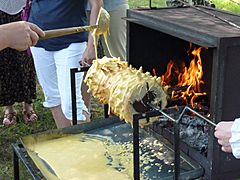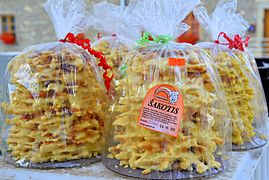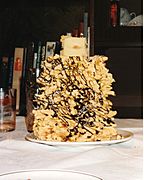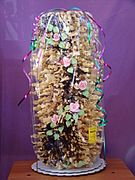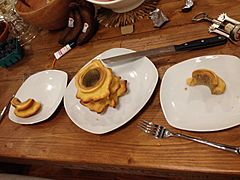Šakotis facts for kids

Lithuanian šakotis
|
|
| Alternative names | Sękacz (Poland) Bankucha (Belarus) |
|---|---|
| Type | Cake |
| Region or state | Lithuania, Poland, Belarus |
| Created by | German Baumkuchen |
Lithuanian šakotis or raguolis ("tree cake"; literally "branchy"), Polish sękacz, Belarusian bankucha (Belarusian: банкуха) is a Polish, Lithuanian and Belarusian traditional spit cake. It is a cake made of butter, egg whites and yolks, flour, sugar, and cream, cooked on a rotating spit in an oven or over an open fire.
Contents
History
The cake became popular during the Polish–Lithuanian Commonwealth (1569–1791). Its origins are attributed to either the Polish Queen Bona Sforza or the Baltic tribe of Yotvingians. The Yotvingians, first mentioned in 5th century B.C. as neuri, well known as great warriors and hunters, while Bona Sforza is known to have implemented many agriculture, infrastructure and manufacture reforms.
Its name means "branched tree" or "tree with many branches" due to its distinctive shape (it is often conical, like a pine tree, and with the drips as branches). It is baked in a time- and labor-intensive process, by painting layers of batter onto a rotating spit in a special open oven or over an open fire.
It can be decorated with chocolate and flower ornaments, but it is often served plain. Šakotis is one of the most important desserts in Lithuanian celebrations, especially at weddings or other special occasions such as Christmas. It was the sweet chosen to represent Lithuania in the Café Europe initiative of the Austrian presidency of the European Union, on Europe Day 2006.
In May 2015, in Druskininkai, Lithuania the record of the biggest šakotis was broken with 372 centimetres (12.20 ft) height and 85.8 kilograms (189 lb) weight.
In 2006, Masurian sękacz was included in the list of traditional products of the Warmian-Masurian Voivodeship in Poland.
In 2019, the bankucha recipe from Porazava was included in the official list of historical and cultural heritage of Belarus. In north-western Belarus, bankucha is known as a wedding cake made of 60 egg yolks
Other regional varieties
- Austria – Prügelkrapfen
- Belarus – bankucha (derived from the German word Baumkuchen meaning "Tree cake")
- Czech Republic – Trdelnik
- France – Gâteau à la broche
- Luxembourg – Baamkuch has become a traditional dish served mostly on special occasions, such as weddings, christenings, etc. Yet, the cake is available all year around in certain supermarkets.
- Poland – Sękacz
- Lithuania – Šakotis or Raguolis (known as Bankuchenas in Western Lithuania, the word is borrowed from German Baumkuchen) is a similar cake also cooked on a spit, normally over an open fire
- Sweden – Spettekaka with the protected geographical indication (PGI) registered by the EU
- Hungary – Kürtőskalács is a similar cake also cooked on a spit
- Slovakia – Skalický trdelník with the protected geographical indication (PGI) registered by the EU
- Turkey – Makara tatlısı is a similar cake also cooked on a spit.
- Indonesia – Spekkoek (kue lapis legit or spekuk) was developed during colonial times in the Dutch East Indies. The firm-textured cake is an Indo (Dutch-Indonesian) version of the European multi-layered spit cake.
Gallery
See also
 In Spanish: Šakotis para niños
In Spanish: Šakotis para niños



